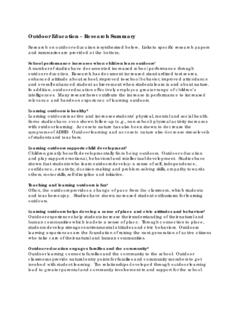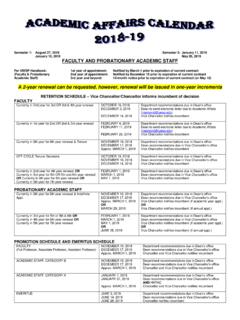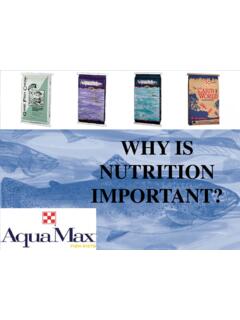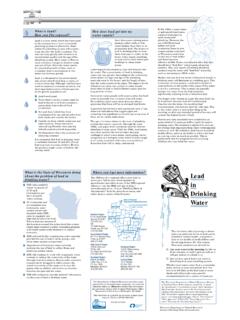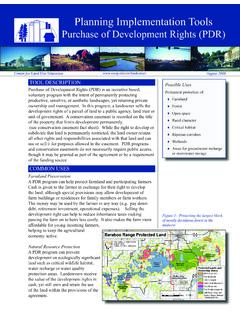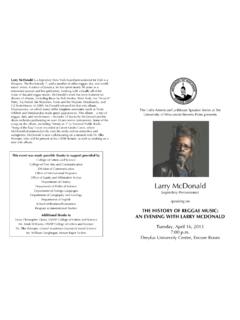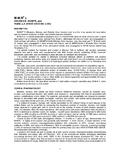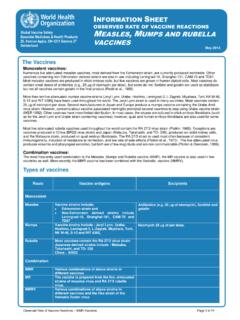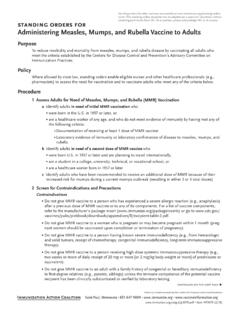Transcription of Measles/Mumps/Rubella -- MMR - Stevens Point
1 - 1 - TO: New Students and Parents FROM: Jim Zach, MD UWSP Student Health Service DATE: February 16, 2009 RE: 2009 2010 IMMUNIZATION RECOMMENDATIONS FOR UWSP STUDENTS The information included here is based on recommendations from the American Committee on Immunization Practices (ACIP) and the American College Health Association for people living in the United States. The immunizations listed are available at no charge if no cost is stated. More information regarding specific immunizations including Vaccine Information Statements (VIS sheets) are available at ROUTINE IMMUNIZATIONS Measles/Mumps/Rubella -- MMR This is an immunization with 3 components.
2 It is recommended that two MMR s be given during childhood. At least 95% of infants properly immunized with one dose of MMR develop adequate protection against measles . The second dose is recommended during the middle childhood years as a booster to protect into later years. University students who have received one MMR should receive a second dose. measles is also known as rubeola, two-week measles , and red measles . An adult who contracts measles can suffer serious illness. Outbreaks of measles occur occasionally on university campuses. One of every 1,000 young adults who get measles is likely to die of measles complications.
3 A prior history of having the disease is not a reliable indicator of immune protection because other diseases can mimic measles . University students occasionally become sick with mumps because they were not immunized, or did not become infected, as children. In addition to salivary gland swelling, this virus may cause inflammation and rarely, sterility of the testicles in adolescent or older males. Ordinarily, rubella is not considered a serious disease. However, it can produce extremely serious consequences if it is contracted by a woman during pregnancy when it can cause deformity or retardation of the baby. If you have had rubella then you have natural immunity to it.
4 However, a history of rubella in childhood is not a reliable indicator of immune protection because several childhood diseases can produce a rash similar to rubella . You may see this abbreviated as MMRV. A fourth component can be added to provide protection for Varicella, which is the virus responsible for chicken pox, and herpes zoster (shingles). If there is uncertainty about immune status, a repeat immunization for rubella , measles , or mumps is not harmful. Blood tests are available to determine if you are immune to these diseases; sometimes testing is required before students work or volunteer in medical settings.
5 Tetanus / Diphtheria / Acellular Pertussis -- Tdap Tetanus is a potentially fatal neuromuscular illness. Its germs can be found widely in our environment and can infect skin injuries which results in production of disease-causing toxin. If you had the initial series of tetanus immunizations (DTaP series) as a child, then you will need a booster every 10 years. A serious wound may require an early booster after 5 or 6 years. Boosters used to be given as tetanus/diphtheria (Td), but as of 2005 pertussis protection was added to this vaccine (Tdap). Diphtheria is a serious throat and respiratory infection that can produce a toxin that damages body tissues such as nerves and heart.
6 A booster every 10 years is recommended. Boosters are especially important if planning travel to countries which are having outbreaks of diphtheria. If you did not receive the DTaP series as a child, it can and should be started as an adult. A dose of Tdap vaccine costs $39 through the Health Service. Pertussis, also known as whooping cough, has been a resurgent disease in recent years. The cough can be quite severe and last for as long as 3 months. A childhood immunization series (DTaP) induces protection against pertussis; however, the protection begins to wear off during teenage years which contributes to the increasing number of cases seen in schools and universities.
7 If someone with a recent Td history desires to acquire the pertussis immunity, recommendations are to wait 2 years since the last Td to receive a Tdap. Receiving tetanus boosters too soon can result in a very sore, inflamed area at the injection site for a couple weeks due to a hyper-immune response. - 2 - Polio (IPV) If you received the initial series of vaccinations as a child, no booster is needed unless you plan to travel to certain under-developed countries where there may be wild polio virus exposure. The recommended form of vaccine for a booster is IPV (Inactivated Polio vaccine). This vaccine is not available through the Health Service but we can help arrange an immunization in the community at the Portage County Public Health Department.
8 Hepatitis B (HBV) Also known as serum hepatitis, this is a viral liver infection transmitted primarily by blood, semen, and other body fluids. This has potential to become a chronic infection and/or disease. It can be fatal. It can be transmitted to intimate partners and from infected women to their child. The American Committee on Immunization Practices and the American College Health Association recommend that all children and young adults receive this immunization. This vaccine is especially important for these high-risk groups: 1. Sexual contacts of gay, bisexual males, or known Hepatitis B virus carriers, 2. Heterosexuals who have multiple sexual partners, 3.
9 Household and sexual contacts of known Hepatitis B carriers, 4. Health care or other workers exposed to body fluids or people with unpredictable behaviors - this includes teachers and teacher s aids, daycare workers, home health workers, nursing assistants, or group home workers, 5. Injection drug users or their sexual contacts, 6. Citizens from high-risk areas such as Asia, Africa, some Caribbean islands, and Eastern Europe and in the US Alaskan natives and Pacific Islanders, 7. Travelers who will be staying in infected areas, 8. Pre-professional healthcare students, such as dentistry, medicine, nursing, and medical technology, 9.
10 Public-safety workers. Students who are 18 years or younger can receive vaccine at no charge because of our participation in a state vaccine program. Students who are 19 years of age pay approximately $50 for the series. If you are 20 years or older this vaccine is available at the Health Service s cost, approximately $90 for a series of 3 shots. Booster doses are not recommended unless one is at high risk of Hepatitis B exposure. As the number of vaccines continues to climb, some manufacturers of vaccines are combining several childhood immunizations such as Hepatitis A and B, or Hepatitis B with DTaP and IPV with the result of fewer shots for children.
